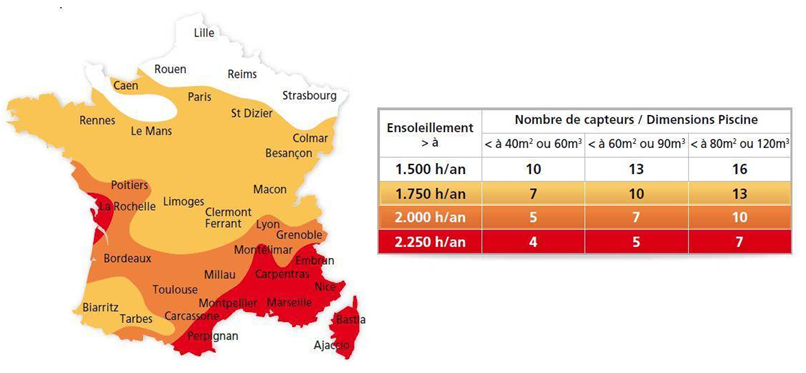
How to set up solar heating for swimming pools?
For a good handyman, the installation of solar collectors for the installation of the solar heating for swimming pool is quite possible . You just need to be orderly, methodical, rigorous, follow the defined plans and the instructions in the manual. The tools used are simple and often available in the toolbox: saws, screwdrivers… But where to start?
Solar heating for swimming pools: how does it work?
The operating principle is simple. The panels use the sun's radiation to heat the water that passes through its sensors.
The panels are directly connected, preferably with a by-pass system, to the swimming pool's filtration circuit.< br>
The by-pass makes it possible to modulate the passage of water or to cut off the solar heating circuit when the water has reached the desired temperature, or to block the circuit when there is no sun. Because without sun, in the event of strong cooling (storm, rain) if the system is left in circulation, the sensors will absorb the ambient cold and restore the cold to the water!
The water recovers the calories absorbed and heats up by circulating in the collectors, then returns to the swimming pool. The water is directed and circulates, thanks to the power of the pool filtration pump, but consider installing a lift pump if the solar panels are installed on a roof or below the pool.
How to determine the number of solar collector?
The number of solar panels intended to heat the pool water is defined according to the volume of water in the pool and the level of sunshine in the region. It takes 0.3 m² of sensors per cubic meter of water, to which must be added an additional ten m² for regions between 500 and 1000 meters above sea level and for those that are windy.

How to choose the type of solar collectors?
There are 4 types of solar heating: rolls, plates, kits and domes, each with its own predestination.
Solar collectors are often presented in the form of a roll whose material is EPDM. This material is particularly resistant but flexible, which allows it to marry the reliefs of the ground. In addition, it is easy to cut and thus adapts to the available surface.
For above-ground pools, there are domes that can be cascaded for small volumes and kits that can heat up to 25 m³. Easier to install, it simply connects to the pool filtration. When the pump is running, the water passes through the sensors which heat it and then back into the pool. This kit is installed at the start of the season and stored away at the end of the season.
The material used for the swimming pool solar collectors installed on the roof is polypropylene. As a result, the panel is more rigid. Thanks to fixing hooks, the installation is simple and quite fast.
Where should the solar collectors be placed?
Choose a sunny, south-facing location. Avoid that in the middle of the day, when the sun is most powerful, shadows, those of the trees or those of the neighboring house, drag on the space occupied by the sensors.
They are installed as close as possible to the pool, to avoid heat loss, especially when the heated water is transported from the outlet of the collectors to the pool.
As solar heating is unattractive, it comes in forms large black bands, it is possible to install it on a roof or below the pool if there is a hill. In these cases, it is usually necessary to add a sump pump. It can also be hidden behind a hedge, a low wall, provided it receives the sun!
To find out more about this method of pool heating, find out here why choose solar heating for your swimming pool and how to maintain and winterize solar heating for swimming pools.